On a summer day in July 2018, sitting on a cement patch in front of her single-storey building, Lindita Qosa fights back tears as she relays the details of the most painful experience of her life. It had been just one month earlier, when Lindita, 21, had been in her ninth month of pregnancy and was expecting her first child.
“After seven years of marriage, God brought me joy,” says Lindita, who was married aged 14. “But just before giving birth, I lost the baby.”
At Lindita’s previous checkup, a whole month earlier, she had been diagnosed with hypertension, or abnormally high blood pressure. It should have triggered medical alarm bells and immediate follow up treatment. But circumstances meant she was unable to follow up and receive the medical care she required, while she was also neglected by the health institutions that should have helped her.
Guidelines for Perinatal Care published by the American Pediatrics Academy and the American College of Obstetrics and Gynecology advise that new mothers with no health issues conduct health checks every fours weeks during the first seven months of pregnancy, with those visits increasing to biweekly and weekly until the child is born.
The reality in Kosovo, however, is very different.
Memli Morina, a gynecologist at a private clinic in Prishtina, says that the past recommendation in Kosovo was a minimum of four health checks during pregnancy, but that has since increased and doctors now recommend at least eight visits.
“A higher number of visits influences the discovery and management of potential complications,” he says, adding that with eight medical visits before birth, the risk of perinatal death — deaths that occur anywhere from the 22nd week of pregnancy to the sixth week after birth — is reduced to 8 in every 1,000 births.
For many pregnant women in Kosovo, it is simply unrealistic to expect this number of checkups. And for women from minority communities such as Lindita, who is Roma, the likelihood of receiving even a basic level of prenatal care are reduced still further.
For example, Lindita says she only received three checkups throughout her pregnancy.
She is part of the 23 percent of Kosovar women from the Roma, Ashkali and Egyptian communities who do not receive the recommended minimum of four health check ups before giving birth, according to a UNICEF report published in October 2017. That figure is 15 percent higher than that of the general population.
The results are as shocking as they are inevitable.
Based on data provided by the Multiple Indicators Cluster Survey 2013-14, published by the Kosovo Agency of Statistics (ASK) in October 2014, the mortality rate for infants in the Roma, Ashkali and Egyptian communities is 41 in 1,000. This is more than three times higher than the corresponding rate for the general population, which is 12 in 1,000.
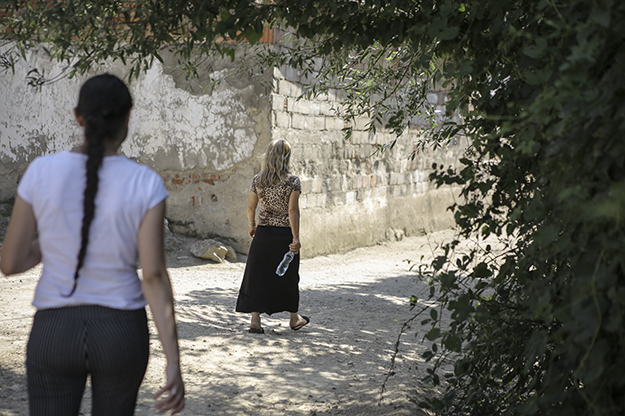
Widespread poverty and discrimination against Roma, Ashkali and Egyptian women limits their access to health care, even during pregnancy. Photo: Arbër Murturi.
Lindita was already 39 weeks pregnant by the time she had her third checkup at the Gynecology Department of the Mitrovica General Hospital in the south of the city. It is 3 kilometers away from the 2 Korriku neighborhood in which she lives — 90 percent of which is comprised of Ashkali people.
It was at this appointment on May 16 that medical staff determined Lindita had hypertension, a potentially serious condition for pregnant women.
According to the National Health Service of England, as a result of untreated hypertension, women can experience the development of pre-eclampsia and eclampsia, which can lead to complications that threaten the life of both the mother and the child. A 2012 publication by the American Pediatrics Academy and the American College of Obstetrics stated that complications that are the result of hypertension and pre-eclampsia are one of the main causes of mortality among mothers and infants.
Based on Lindita’s case report, Avni Fejza, director of the Gynecology Department, confirmed Lindita’s visit and that her hypertension had been diagnosed, and said that she was advised to travel to Prishtina for further medical attention.
“Based on the data of the diagnosis in our records, Lindita’s baby was alive when she was checked,” Avni Fejza says.
But Lindita didn’t travel to Prishtina. She couldn’t.
“They told me to go to Prishtina because I had hypertension,” she says. “Where do I get the money to go to Prishtina? We make a living from the bottles and metal that my husband collects.”
Lindita, who lives with her husband and nine other extended family members, explains that nobody in her family has completed elementary school and that all 11 family members live entirely off of the money her husband, 33-year-old Ibrahim, makes transporting the metal that he and his neighbors collect during the week to the market.
For each trip, Ibrahim receives around 5 euros. Every Saturday, he earns up to 20 euros.
Lindita says that her family’s income typically sums up to 100 euros per month. According to the state’s social assistance scheme, which provides payments to families in poverty based on the cost of essential food items, one 11 member family needs 125 euros per month to feed each person the recommended number of daily calories.
Fifty-four percent of Roma, Ashkali and Egyptian families have a monthly income from 0 to 200 euros a month, according to research published by the Kosovo Education Center in 2016; whereas the United Nations Development Program stated in a 2011 research study that the general level of unemployment among these communities is 60 to 80 percent.
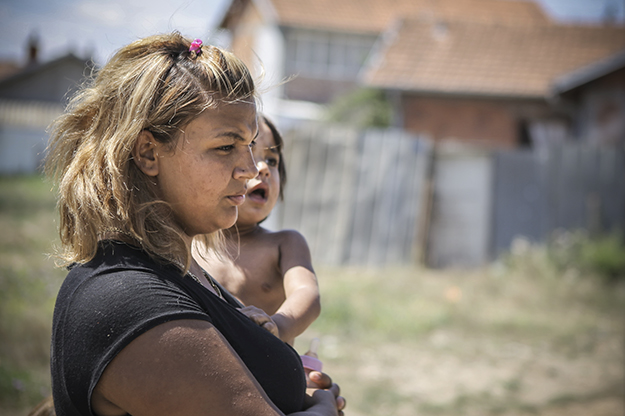
Lindita Qosa, 21, holds her brother-in-law’s child. Qosa lives beneath the poverty line with her 11-member family. Photo: Arbër Murturi.
“My husband has problems with his back and cannot lift heavy weights,” says Lindita, adding that his back injury is the result of heavy weight lifting in the past. “During weekdays he lifts metal that does not weigh too much, therefore the profit is lower.”
Citing a shortage of funds, Lindita says that she returned home without being treated for high blood pressure, instead of going to the University Clinical Center of Kosovo (QKUK) for the recommended, and essential, care.
A month after the appointment, Lindita says she made the decision to go to the General Hospital in the north of the city — known as July 30th — which operates within Serbia’s health care system. It was there that she says she was told that her child had been dead for a week and where her deceased infant was delivered.
Lindita says she was admitted to the hospital on June 13, two day before Bajram, which would mean she was in her 43rd week of pregnancy. While her admission was confirmed by deputy director of the Gynecology Department Saša Zakić, he revealed no further details about her case, citing patient confidentiality.
Lindita says she needed more information rather than to simply be diagnosed with hypertension and be directed to Prishtina.
The emergency clinic of QKUK has a specialized unit for emergency gynecology-obstetrics treatment that Article 8 of Kosovo’s Law on Emergency Medical Service says patients should be referred to in emergency cases. Following her third visit to the hospital in south Mitrovica a month earlier and the diagnosis of hypertension — a potentially life-threatening condition for both unborn child and mother in the latter stages of pregnancy — the hospital was legally obliged to offer Lindita an ambulance directly to the clinic in Prishtina for the recommended treatment, but Lindita says the hospital never made that option available to her.
“The ambulance is not a taxi service,” says the director of the Obstetrics Department of the Mitrovica General Hospital, Sadik Fejza, who asserts that because Lindita was never directed to QKUK via the emergency services’ ambulance, she was not in danger at the time.
Lindita says she needed more information rather than to simply be diagnosed with hypertension and be directed to Prishtina. In previous health checks, she had been told she was OK. “In the Mitrovica [General] Hospital, they said I was fine,” she says. “In the end, it turned out that I wasn’t.”
The director of the Obstetrics Department, Sadik Fejza, says that this is just gossip. “She can follow the legal route through responsible bodies for investigation,” he says.
But Lindita says: “Complaining won’t bring back my child.”
Experiencing discriminatory treatment
Throughout the course of Lindita’s pregnancy, she says she experienced various forms of discrimination. One was in April, when in her eighth month of pregnancy, she fell down while installing curtains by the windows of her house. Afraid of losing her child, she went to the Mitrovica General Hospital — one of her three visits — to get checked.
“Doctors told me that I wasn’t due to give birth and that I had to wait,” she says. “I told them that I wasn’t there to give birth, but that I had fallen down. They still told me, ‘Nothing is wrong with you.’ I waited in a corridor for one hour until finally a doctor checked me… after all his Albanians had gone in.”
Lindita says that she has felt discriminated against many times in this hospital, which she attributes to her ethnicity. “They look at us badly, because we are Roma,” she says.
But the law states that patients should be guaranteed equal treatment in health care institutions.
“Every citizen is entitled to health care … [that] should be adequate and continuously accessible to all without discrimination, ” reads Article 4 of the Law on the Rights and Responsibilities of the Citizens in the Healthcare. Furthermore, the Law on the Protection and Promotion of the Rights of Communities and their Members states that the government must undertake necessary measures to ensure that minorities have equal access to healthcare, without discrimination.
But as Lindita says was the case in her experience, medical professionals do not always abide by such laws.
The Mitrovica Regional Hospital wouldn’t confirm Lindita’s visit in April, but the director of the Obstetrics Department, Sadik Fejza, opposes her statements in principal.
“They are treated like all other patients. The fact that they belong to minority communities makes no difference,” he says. “The door is always open to them. But those women do not visit our clinic.”
Lindita feels that she was treated with more dignity in the north than in the south. Besides the care she received from doctors, she also praised the fact that she received more medicine in the north.
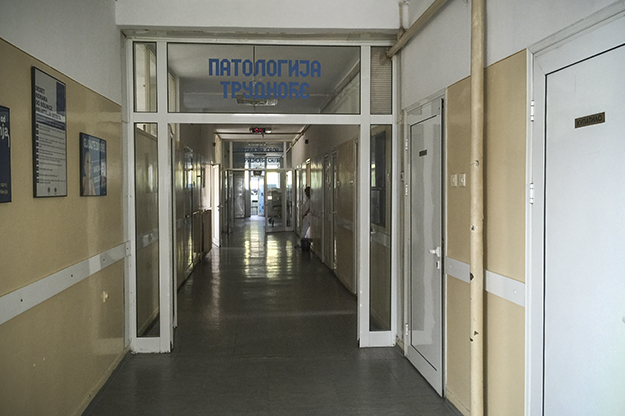
The July 30th hospital in the north of Mitrovica treats more Roma, Ashkali and Egyptian women annually than the south’s Mitrovica General Hospital, where minority women say they face greater discrimination. Photo: Artina Muqiqi.
Based on statements given by the two Mitrovica hospitals, the number of patients from the Roma, Ashkali and Egyptian communities that go to get checked is higher in the north. Zakić says that 15 to 20 percent of patients treated in the Gynecology Department of the July 30th Hospital belong to minority communities.
“Women from these communities generally visit for checkups or for interventions,” he says. “Few of them come to give birth because of problems with documentation that they may have, because children need to be registered in the place where they are born.”
In the Serb-majority north — where Kosovo’s state institutions have little influence — Kosovo’s system and Serbia’s parallel system operate independently from one another. Data about the registration of births from Serbian institutions are not registered in the Kosovo system.
According to a UNICEF report, this particularly affects the Roma, Ashkali and Egyptian communities, “which were registered in the Serbian parallel system and have faced problems related to inclusion in Kosovo institutions” as the two sets of institutions do not communicate or exchange data with one another.
The Mitrovica General Hospital in the south said it was unable to provide the number of births for the three communities, justifying that they do not register infants based on ethnic background. However, according to the director of the hospital’s Obstetrics Department, the number of women from these communities that come to give birth is higher than that of those who come to get checked.
The director of the Gynecology Department, Avni Fejza, says that doctors often fear these cases. “We often do not know whether or not they’ve conducted regular checkups and what complications they’ve faced,” he says.
The number of births in the Mitrovica General Hospital in 2017 was 1,496, whereas by August 2018 there had been 973 recorded births; one death has been recorded each year. In north’s July 30th hospital, deputy director Zakić says that there are 800 registered births per year, but has not provided requested data on the number of deaths. The southern hospital referred 17 infants with serious health complications and specific treatment needs to the Neonatology Clinic at QKUK in Prishtina, the referral point for newborn infants with pathologies in all regional hospitals; 209 infants died here in 2017.
The sense of discrimination is not limited to mothers in Mitrovica. It is shared by other minority community members living in Kosovo, including 29-year-old Lendita Qallaku, who is of Ashkali origin and lives in 7 Shtatori neighborhood in Peja.
Lendita couldn’t sleep from maternity pains in the early morning of June 15, 2015. She and her husband Shaip, and the five other members of their family, were soon to be accompanied by a new member, Fatlum. It was her sixth birth, so Lendita believed that she had nothing to worry about. But by 20:45, she was admitted to the Peja General Hospital after experiencing serious pain.
“Doctors constantly told me, ‘There’s still nothing,’” Lendita says. “I got up from the bed and went to the toilet. That’s when I noticed that the baby had started to come out. There was another pregnant woman in the corridor, and when she saw me, she notified the doctors immediately. When they saw me, the nurses started to shout at me, asking why I had gotten up from the bed.”
Lendita was baffled by the negligence of the doctors in this critical moment.
“Even without settling in bed properly, the baby came out. Had the nurse not held him in her hands, I wouldn’t have had my son today,” she says. “I had told them constantly that I had started to give birth, but the doctors wouldn’t come. I don’t know why they look at us badly.”
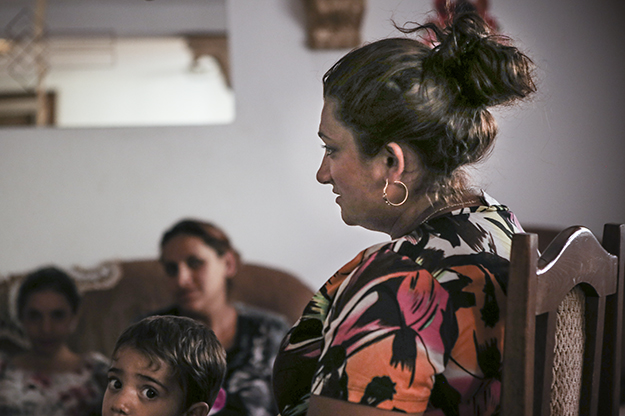
Lendita Qallaku, who lives in the 7 Shatori neighborhood in Peja, says that doctors neglected her during critical moments of her pregnancy. Qallaku, an Ashkali woman, attributes this to discrimination. Photo: Arbër Murturi.
In the official records of the Gynecology Department of the Peja General Hospital, this birth is registered as having been “spontaneous.” “Right after birth, the baby was in good health. The birth was spontaneous, without anomalies or other health issues. This is registered as Lendita’s sixth birth,” says the department’s director, Ramadan Dacaj.
Dacaj says that the process of giving birth is complicated and that it differs with every woman, therefore doctors cannot be blamed for everything.
“At the moment of birth, women think that we aren’t doing anything. The process of giving birth can start 24 hours earlier, but the exact starting point is unknown,” he says. “It can start on the floor, on the toilet, or wherever. It’s important that the mother and child are in good health.”
Dacaj points to his department’s record in general, with 2,017 births registered last year and 11 infant deaths; until October 25 this year the department had registered 1,617 births with four infant fatalities.
“In the last five years, we have not registered any deaths of mothers in the department,” Dacaj says. “And the number of deaths of infants is low, too.”
He categorically denies the suggestion that anyone is treated differently based on their ethnicity. “As the director of the department, I haven’t noticed discriminatory elements or any different treatment of minorities,” he says, estimating that between 20 and 30 percent of patients treated in the Gynecology Department are Roma, Ashkali or Egyptian. “We haven’t had complaints.”
However, there is various evidence that discrimination against women from minority communities is a widespread phenomenon in Kosovo’s health care services.
A 2015 research study conducted by Solidar Suisse and Balkan Sunflowers, states that ethnicity-based discrimination is one of the main barriers for members of the Roma, Ashkali and Egyptian communities in accessing and utilizing health care services. According to the study, 50 percent of respondents — out of the 1,592 people surveyed — from these communities say that their relatives avoided health care services due to lengthy waiting times for general and specialist treatment.
“If I were to say that there is no discrimination, I would be lying,” says Agnesa Toska, an activist with Prospekt+, a project supporting minority communities that is implemented by the Peja-based democratic participation NGO Syri i Vizionit.
“Women have complained occasionally that they are not receiving medical checkups, that they are being left to wait, that they have not been admitted to hospital after being told that they were unclean. There have been cases when we have conducted observations and we have seen that they were being left to wait for a very long time, and they were treated with negligence while doctors took prolonged breaks or treated people they knew.”
According to data provided to K2.0 by the Kosovo Judicial Council (KJC), in the Serious Crimes Department there were five cases of irresponsible medical treatment and four cases of failure to provide medical assistance in 2017. Similar figures were registered in 2016 and 2015.
General departments of courts, which handle less serious cases, receive more cases, according to KJC. For example, in 2017 the number of cases was higher than either of the two preceding years, with a total of 18 cases of irresponsible medical treatment and a further 27 cases of failure to provide medical assistance.
However, KJC did not provide specific data about whether these cases included members of ethnic minority communities.
While they are often not reported to the courts, women from minority communities complain of cases of discrimination by medical institutions throughout Kosovo, including at QKUK, which serves as the biggest hospital center in the country.
It was here that Valbona Berisha, a 26-year-old Roma woman, went to be treated on June 17, 2017.
She had just given birth to her third child in one of the rooms in the six floor building in Plemetina, Obiliq in which 36 Roma, Ashkali and Egyptian families reside. Her other two children had also been born at home, but after giving birth that day, Valbona’s husband Safet sought help from their neighbors to take her to Prishtina for post-natal care.
Little specific data exists regarding women from Roma, Ashkali and Egyptian communities who have given birth at home, but according to a 2014 report by the Kosovo Agency of Statistics, 98 percent of births delivered by women from these communities take place in public health care institutions. The Director of the Neonatology Clinic at QKUK, Xhevdet Gojnovci, says that in 2017 there was only once case in which medical treatment was sought after giving birth at home. This year, he says that there have been no such cases.
“One of the doctors said, ‘When you don’t have the means, why are you giving birth?’” Valbona recalls.
When Valbona was taken to QKUK, she didn’t bring personal items like clothes, sheets, diapers, bottles or food, all of which doctors in the public sector often suggest people buy themselves.
But Valbona and Safet receive social assistance from the state as they are officially considered to be a family living in poverty.
“One of the doctors said, ‘When you don’t have the means, why are you giving birth?’” Valbona recalls.
Such comments are not unheard of in Kosovo’s public sphere. Former Minister of Economic Development Blerand Stavileci had also made a similar statement during a TV interview in February 2015.
“In many cases, there might be people who lack knowledge about family planning and financial education,” Stavileci said. “I don’t think that in the 21st century, a person who receives a wage of 300 euros should have a family of seven members. They should know their capacity. They are burdening children who are one, two or three years of age. Why? Because they didn’t plan properly.”
The executive director of the Kosovar Center for Gender Studies NGO, Luljeta Demolli, counters such a narrative, saying that economic leaders should know that the discrepancy in birth rate between different segments of the population are directly related to high poverty levels and the structural problems that come as a result of unequal educational opportunities.
“A politician who is in such a position cannot blame poor citizens for their lack of family planning when the state institutions — which he is a part of — are not engaged in creating efficient policies for raising socio-economic awareness among [those living in poverty],” Demolli says.
“Before giving moral lectures, state representatives should make sure that they have done what is needed from their side to provide substantial information to different social stratas about the interdependence between individual responsibility and institutional responsibility — including the issue of family planning.”
However, analyses of the economic conditions of minority communities and their integration into society have highlighted that institutional actions have achieved weak results. A 2017 report financed by the European Commission and the Open Society Foundation, criticizes Kosovo’s government for its lack of steps to implement its Strategy for the Inclusion of Communities, and highlights that work needs to be done to economically integrate minorities.
“This integration would contribute to the construction of social cohesion and would improve efforts to respect basic rights, including the rights of communities, and would also help to eliminate racial, ethnic and social discrimination,” the report reads.
When it comes specifically to health care, structural shortcomings are further highlighted in a 2016 report by Kosovo Women’s Network, which shows that people from most ethnic minority communities face more difficulties when accessing health care services compared to the majority Albanian population. Financial, geographical and cultural issues are mentioned as some of the main causes.
The report found that in addition to generally having significantly greater financial barriers than the majority Albanian population, members of minority communities also often face geographical issues, because they tend to live in rural areas, which are more isolated and further away from health care institutions. Kosovo Women’s Network also says that access to transport may influence health care access, with 51 percent of Roma, Ashkali and Egyptians surveyed reporting to have walked to their most recent doctor visit.
Short supply in state medicine leaves women without treatment
According to the 2015 study conducted by Solidar Suisse and Balkan Sunflowers, 80 percent of respondents from the Roma, Ashkali and Egyptian communities said that they do not visit the doctor because they cannot afford to pay for treatment or medicine.
In public hospitals, where medical treatment is free, medicine is often prescribed to be purchased in the market, even supplies that are supposed to be paid for by the national budget.
Lindita Qosa says all the medicine that was prescribed to her in the Mitrovica General Hospital in the south of the city was prescribed to be purchased, but during her treatment in the hospital in the north, when she lost her baby, it was provided for her.
Due to the financial cost of the therapy prescribed to her when she was diagnosed with hypertension, Lindita says that it was difficult to manage her pregnancy. Representatives of the Mitrovica General Hospital admit that they are not well equipped when it comes to medical supplies.
“We are forced to tell patients to purchase medicine themselves,” says Sadik Fejza, director of the Obstetrics Department. “If they don’t have them, we don’t have them either.”
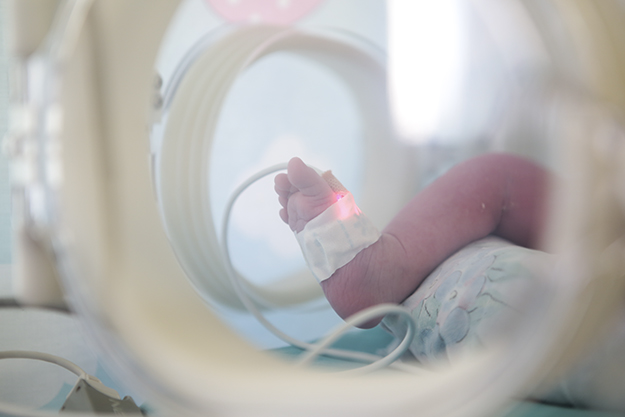
Hospitals around Kosovo face shortages of both medicine and medical equipment, including those essential supplies that are supposed to be supplied by the state. Photo: Arbër Murturi.
The Ministry of Health produces an Essential Medicines List containing medicines for basic public health that should be supplied to hospitals and covered by the state budget. But many of these medicines are also in short supply at QKUK, according to the director of the Gynecology Clinic, Myrvete Paçarada. “Sometimes we have a certain medication, then we don’t,” she says. “When we’re running low on stock, we tell patients to buy the medicine themselves.”
But not all patients can afford to do so.
“Some of the medicine prescribed to me [in Mitrovica] cost 5 euros, 3 euros,” Lindita Qosa says. “Where can I get that money when no one in my family is working? I was rarely able to buy them.”
Activist Agnesa Toska from Syri i Vizionit in Peja says that during the organization’s activities she became aware of many cases in which women from the Roma, Ashkali and Egyptian communities were not only unable to buy prescribed medicine, but were also unable to buy contraceptives and IUDs for preventing unwanted pregnancies.
In Fushë Kosovë, activist Bajramshah Shala often buys medicine to give to women from minority communities in a pharmacy close to the 28 and 29 Nëntori neighborhoods, which are predominantly inhabited by Roma, Ashkali and Egyptian families.
“They cannot buy medicine that is prescribed to them for therapy, and they are left in a bad situation,” says the activist, who works for the Ideas Partnership, an NGO mainly focussing on the education of minority communities. “If we don’t give it to them, they might never have access to them.”
Earlier this year, Minister of Health Uran Ismaili pledged to improve the system of planning and distributing essential medicines. “We have created an updated monitoring system for stock and contracts [for supply], which will enable us to track the demand up to four months before the expiration of contracts,” wrote Ismaili on his official Facebook page on March 3.
But based on data provided to K2.0 by the Central Pharmacy for Pharmaceutical Services – QKUK/SHSKUK, there has been no improvement regarding the supply of medication on the Essential Medicines List compared to previous years.
For the first six months of 2018, the Central Pharmacy only met 65 percent of the demand for medicine by different clinics, 55 percent of the demand for basic medical supplies, and 50 percent of the demand for cytostatics (which are often used in cancer treatment). These numbers are similar to 2017 when it met 62 percent of the demand for medicines, 54 percent of demand for basic medical supplies and 45 percent of demand for cytostatics.
The situation was actually better in 2016 when medication supply reached 70 percent of demand, and basic medical supplies and cytostatics 60 percent each.
The sensitive pharmaceutical industry has continuously faced issues in terms of product quality and corruptive relations between doctors and supplying companies, as well as inflated prices of medicine and other issues. According to a report published by the Columbus Institute in May 2018, around 200 medicinal products and equipment were purchased by the Ministry of Health at inflated prices. The report also states that the budget for the Essential Medicines List is growing, but that this is not being reflected in a better supply of medicines in public hospitals.
Donations help to supply the clinic with not only medicine, but also technology and medical devices, and help to compensate for the shortage of medication from the Essential Medicines List.
The Central Pharmacy did not provide specific data about supply at the Gynecology Clinic or the Neonatology Clinic at QKUK. However, unlike in the Gynecology Clinic, where medicine is often in low supply according to its directors, in the Neonatology Clinic the situation is reportedly better thanks to donations.
The director of the Neonatology Clinic, Xhevdet Gojnovci, says that they received donations from NGOs, foundations and pharmaceutical companies at a value of 150,000 euros in 2017 and had brought in 50,000 euros through June 2018.
The donations help to supply the clinic with not only medicine, but also technology and medical devices. This year, for example, Action for Mothers and Children donated a piece of apparatus for measuring the rate of the chemical compound bilirubin, allowing doctors to detect cases of hyperbilirubinemia, which can cause brain damage. The device typically costs around 3,000 euros. Further donations included portable ultrasound devices at a value of 17,000 euros, as well as medicine such as Tobramycin, Dexamethasone and Metronidazole for treating infections and inflammation.
Moreover, the clinic received 30 packs of clothes for children that require social assistance, as well as medicine and basic medical supplies at a value of 6,000 euros from Care for Kosovo Kids. Other donations received include disinfectants, powdered milk and apparatuses for disinfection from Medikos Pharm, 400 pieces of OVE film for scans from Medica Kosova, cartridges for analyzers that measure the rate of carbon dioxide in infants from Kosova Export Import Supply Pharmaceutical, and administrative equipment from NLB Bank.
According to Gojnovci, the donations have helped to compensate for the shortage of medication from the Essential Medicines List.
NGOs provide where the state lacks
Among the small damaged houses in Fushë Kosovë’s 28 and 29 Nëntori neighborhoods is a three-storey building where pregnant Roma, Ashkali and Egyptian women are brought together by the Ideas Partnership each Wednesday.
During the meetings, the organization provides talks on unwanted pregnancies and family planning, and also makes free health checks available. Thirty women participated in these activities in July 2018 alone.
The Ideas Partnership believes that it is important to raise awareness among women because the lack of information about protecting against and avoiding unwanted pregnancy, as well as economic conditions, leads to an increase in the number of abortions in these communities.
A 2016 report by the Ombudsperson states that 37 percent of Roma, Ashkali and Egyptian women reported having had an abortion. According to the same report, only 19 percent of women from these communities use modern methods of contraception and protection.
Furthermore, the Multiple Indicators Cluster Survey 2013-14 conducted by ASK found that girls from these minority communities are more likely to give birth before the age of 18 and have less information on how to protect themselves from unwanted pregnancies.
On July 6, 2018, in an activity organized by the Ideas Partnership, a 40-year-old Roma woman spoke with a doctor about her issues, believing that she was pregnant.
“My periods are late. I have six children. I might be pregnant again. I feel tired,” she said.
There were no pregnancy tests in the center, so the doctor advised her to go to the Family Medicine Center in Fushë Kosovë to get checked.
“You don’t want to be pregnant?” asked the doctor.
“No, I’m ashamed,” said the woman. “I’m old. My daughter is 20. She’s engaged.”
“Go to the doctor on Wednesday,” said the doctor, advising the woman to speak with her husband about her option to abort the pregnancy if the test came back positive.
“My husband doesn’t want me to be pregnant either,” the woman said.
“When you go there, tell the doctor what you told me. You are 40 years old, giving birth can be dangerous at this age,” said the doctor.
The woman had no money to buy contraceptives, and she had used up what she had been given at the center a while back.
Expectant mothers from minority communities also take part in classes organized by the Action for Mothers and Children at QKUK’s Gynecology Clinic at 12 noon on Tuesdays and Fridays. At these sessions, patients who are close to giving birth are advised about techniques for easing pains during birth, taking care of cesarean scars, nutrition, breastfeeding and general care for infants.

NGOs work to provide women of minority communities with access to education and contraceptives. Photo Courtesy of Syri i Vizionit.
A similar effort takes place in 7 Shtatori neighborhood in Vitomerica on the edge of Peja, where Syri i Vizionit organizes a campaign for family planning among minority communities. These informative meetings with women are held every month and last for one hour. Since few of the women know how to read and write, the activities are mainly video based.
Lendita Qallaku was one of the women who took part in these informative meetings. After giving birth to four children she had six abortions, all of which she completed with pills after the 10th week of pregnancy.
Despite the multiple abortions, Lendita became pregnant twice more and gave birth to two more children. After giving birth to a boy in Peja General Hospital, Lendita says she sacrificed her food just to find a solution to prevent pregnancy. She found that solution in the form of birth control injections, which she received every three months and cost her 20 euros every 12 weeks.
“I took injections for three years,” she says. “My periods stopped and I’ve gained a lot of weight, so I’ve stopped taking them.”
Injections are one of the methods of protecting from unwanted pregnancy. According to gynecologist Memli Morina, injections — also known as Depo-Provera — are given once every three months and are considered a safe contraceptive method. “If the injections are taken regularly, there is a very low chance of pregnancy,” he says.
Lendita is currently not using contraceptive methods for protecting herself from unwanted pregnancy and is waiting to regulate her menstrual cycle so that she can review her doctor’s recommendation of fitting an IUD.
Support from organizations enables women to have easier access to clinics in which they seek health care services. Syri i Vizionit’s Agnesa Toska says that the presence of a third person is important. “Communication and access changes the moment someone goes there with them,” she says.
In the first half of 2018, a total of 30 women from two neighborhoods in Fushë Kosovë gave birth after being aided by The Ideas Partnership; last year they helped 65 women in total.
The Ideas Partnership also provides women transport for giving birth or getting checked at gynecological centers.
“Women have my number. I’ve told them they can call me whenever,” activist Bajramshah Shala says. “I’m not lazy, I don’t mind even if they call me in the middle of the night. There have been cases where I’ve run in my pajamas, I’ve just put on a jacket and some pants and taken them to the hospital to give birth.”
Shala often waits outside the maternity room until she’s told the women have given birth and that their condition is stable.
Hundreds of women have been helped by The Ideas Partnership alone. From January to June 2018, a total of 30 women from two neighborhoods in Fushë Kosovë have given birth after being aided by the organization, which began offering these services in 2013; last year they helped 65 women in total.
In QKUK’s gynecology and neonatology clinics, nurses from Action for Mothers and Children care for women so that they do not feel discriminated against.
“There have been cases when we have had three patients from the [Roma, Ashkali and Egyptian] communities and we didn’t situate them all in one room, so that they could socialize with other communities,” says nurse and lecturer Qamile Begolli Zeqiraj. “In three beds, we situated one Roma woman and two Albanian women.”
Such initiatives, however, are currently entirely dependent on the existence and capacities of third sector organizations.
Meanwhile, discrimination and exclusionary treatment prevail in public institutions. For women of the Roma, Ashkali and Egyptian communities, this means constant insecurity and a lack of support for their health, and the health of their babies.
Editing by Artan Mustafa.
Additional editing: Besa Luci, Jack Butcher.
Language editing: Lauren Peace.
Feature image: Arbër Murturi.
This article was written as part of K2.0’s Human Rights Journalism Fellowship, 2018.

Back to monograph








